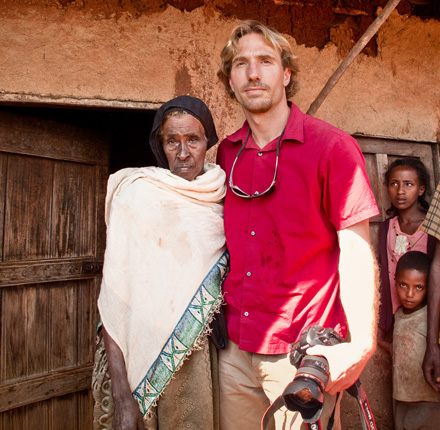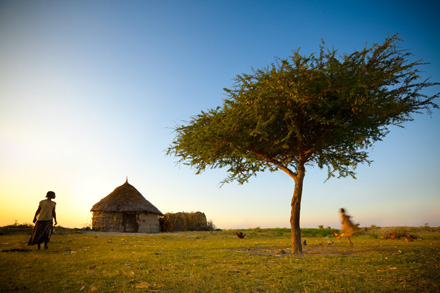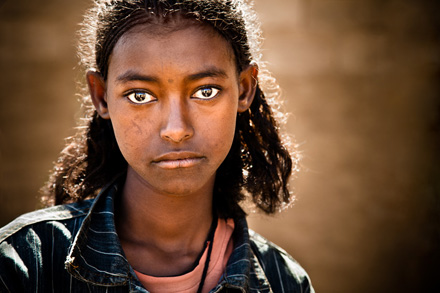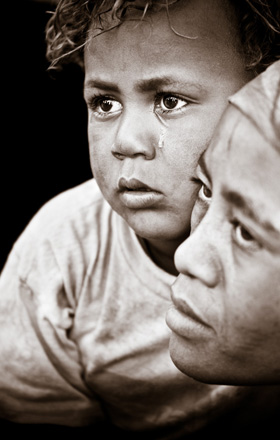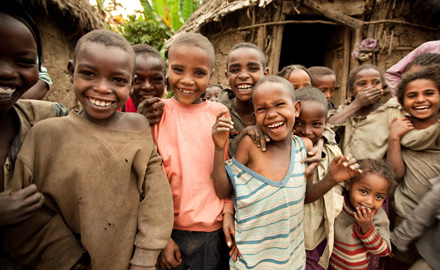Hi all,
It’s a real honor to be writing today, and I want to thank Scott and Brad for the bandwidth. I’d like to share a behind-the-scenes story about the most exciting project of my career.
I’m an adventure photographer in Aspen, Colorado. When I first picked up a camera 15 years ago, I was tickled at the idea of being paid to rock climb, ski and travel. I certainly didn’t get into photography to “make a difference.” Indeed, from a cynical bent, you could say that I shoot leisure sports — images of rich white people overindulging in the outdoors.
Last winter, however, I turned my lens in the other direction. My wife and I were about to adopt a young boy from Ethiopia. As I read about the country’s poverty crisis (it’s one of the 10 poorest places in the world, with a mind-boggling 5 million orphans), I had pangs of guilt over our decision. We were spending thousands of dollars to haul a child to America when, one could argue, the money could go much further keeping at-risk parents alive. If we really cared about the welfare of our new boy or his Ethiopian peers, wouldn’t it be better to keep his family healthy and fed in the first place, rather than opportunistically adopting him as an orphan?
Sadly, that option wasn’t possible in the case of our boy, but along the way I learned about some impressive work the adoption agency was doing to help stop the orphan crisis. Wide Horizons For Children runs a nonreligious humanitarian-aid program that builds health clinics, clean-water projects and schools; and it sponsors destitute children and orphans to help them thrive in their home communities, rather than being placed for adoption.
Like many nonprofits, Wide Horizons’ work is world-class but their marketing materials are anything but. Poorly lit snapshots comprised the bulk of their campaign. I volunteered to shoot a multimedia fundraiser, documenting Wide Horizon’s outreach in Ethiopia’s remote and hard-hit communities.
And that’s how I found myself in northern Ethiopia’s war zone of Rama last December, one of the poorest regions on earth. Here, I faced an entirely real marketing question: What type of images or video would compel donors to open their wallets?
Before I left, a friend at Stanford University’s Center For Social Innovation shared a fundraising secret. It turns out that donors are moved not by staggering statistics or photos of mass suffering, but by an image of a single human being. People feel helpless when confronted with the enormity of Africa’s need (and for good reason) — yet when presented with the story and portrait of one individual whose life can be directly improved, checks are signed.
That simple fact became my creed — get in tight and focus compassionately on every person I shot. I brought two Canon 5D Mark II cameras, four lenses, a tiny carbon-fiber tripod and a CompactFlash audio recorder. I alternated between shooting stills and video whenever one seemed more powerful than the other, and used the week to learn video skills. (You can judge whether I chose stills vs. video appropriately in the final video below — I am sure there are always better ways!). I traveled with local Wide Horizons workers, Ethiopians who had grown up in the very villages we were working in, who translated our interviews.
To start, I wanted to introduce Ethiopia as a beautiful country, one with rich culture and tourism. So I shot scenes like this.
I next wanted to introduce hardship and poverty on an individual level, using faces like this one of 12-year-old Frehiwot Abera to hit the point home. Frehiwot lives in Rama, a town ravaged by war, famine and AIDS. She lost both of her parents before she was 5, and lives with her unemployed aunt.
Frehiwot is one of the “lucky” ones fortunate enough to receive a child sponsorship through Wide Horizons. An American family spends about $1 per day to help provide her with food, school fees and economic counseling that has helped her launch an entrepreneurial venture of raising sheep and chickens for sale. Frehiwot’s story of hardship, and her economic turnaround, moved me to tears.
Yet for every sponsored kid, there are many more in need. To succeed in my goal, I had to find a way to show donors a compelling reason to give more. That’s when my job got hard.
I introduced myself to sick, destitute people on the street, and asked if I could take their pictures. I felt like an ambulance chaser, a paparazzi of the poor. Entire streets of people would stop to stare at me as I lay down next to an ailing woman on the sidewalk and trained my lens on her. The only thing that carried me through these humbling, self-conscious shoots was the hope that my images just might hit home with potential donors.
I shot 20-year-old Bethlehem Demesy and her 4-year-old son Nahom in a landfill, where home is an overturned dumpster. Bethlehem’s parents died in her early teens; begging and prostitution for pennies have provided her only means of survival, placing her at extreme risk for HIV infection. (In a country with 30% unemployment, there’s no “career center” for orphaned teens to turn to). I pray that Bethlehem’s story will encourage donors to see the impact that a child sponsorship could have for a teenage girl at risk.
Finally, I wanted to show the powerful work Wide Horizons was doing to build health clinics, schools and water systems. This was the fun part, as the townspeople were bubbling over with excitement about the projects. Shooting in Ethiopia was the greatest adventure-travel trip of my life — the agency workers introduced me to wonderful people whom I never would have met as a tourist.
I returned home with a week’s worth of material (and an Ethiopian son named Masamo; my wife joined me in Addis Ababa after the shoot for the adoption). As a stills photographer, I had NO idea what I was getting into with producing a multimedia video. Who knew it was a hundred times more work than editing stills?!
Salvation came, as it always seems to do, in an unexpected way. At a commercial portfolio review last winter with Kari Niessink, the head art buyer at Crispin Porter + Bogusky, I told her about my Ethiopian project. Kari championed my cause, asking her colleagues Alex Bogusky and David Rolfe if they could produce the video pro-bono. (CP+B is arguably the country’s top ad agency, having been named “Ad Agency of the Year” 12 times.) They said yes — I couldn’t believe my luck!
CP+B integrated editor Nick Schneider and producer Liisa Juola did the heavy yet graceful lifting in bringing the video to life. All told, CP+B donated approximately 200 hours of time to the project.
I debuted the 7-minute video at Wide Horizons’ fundraiser in Boston and New York, where it garnered pledges for over $300,000 to construct new health clinics.
In the process, I realized that as photographers and designers, we are blessed with the skills to create campaigns that will raise far more money than we could ever donate personally.
If you’re still reading this blog, the video is viewable below. There is a larger-res version on my website, and more stories, here.
I offer my sincere thanks to the people who opened their homes and shared their life stories for this project. Meeting those Ethiopians who have endured overwhelming hardship has filled me with an unshakable humility. It was the greatest honor of my life.
-Tyler Stableford
tylerstableford.com
tylerstableford.com/news



